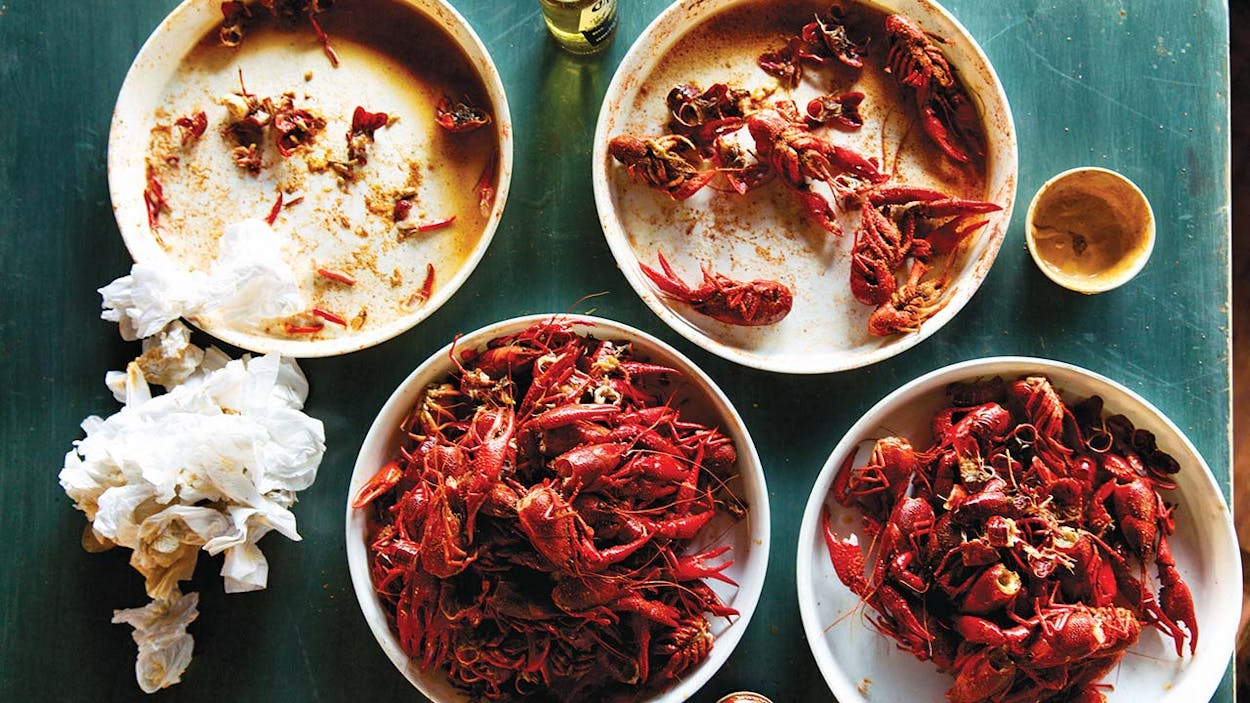To reach Hawk’s Restaurant, perhaps the most storied crawfish shack in the state of Louisiana, you turn off Interstate 10 at the town of Rayne and go north on Louisiana Highway 98, a two-lane blacktop. The road runs a gauntlet of placid, blue-gray ponds studded with wire-mesh traps, their caps peeking just above the water. They are there to harvest the preeminent cash crop of south-central Louisiana: the red swamp crawfish.
After ten miles, you reach Hawk’s Road, a gravel lane curving into a stand of pine and oak trees. It seems to lead nowhere, but after a bend, it transforms into asphalt, and a clearing in the trees reveals a one-story wood-framed building. The entryway is painted bloodred—make that crawfish red—with a caricature of a crawfish stenciled onto a piece of corrugated metal attached to the door. Above that, hand-painted lettering announces “Hawk’s: Home of ‘The Best Boiled Crawfish in the World.’ ”
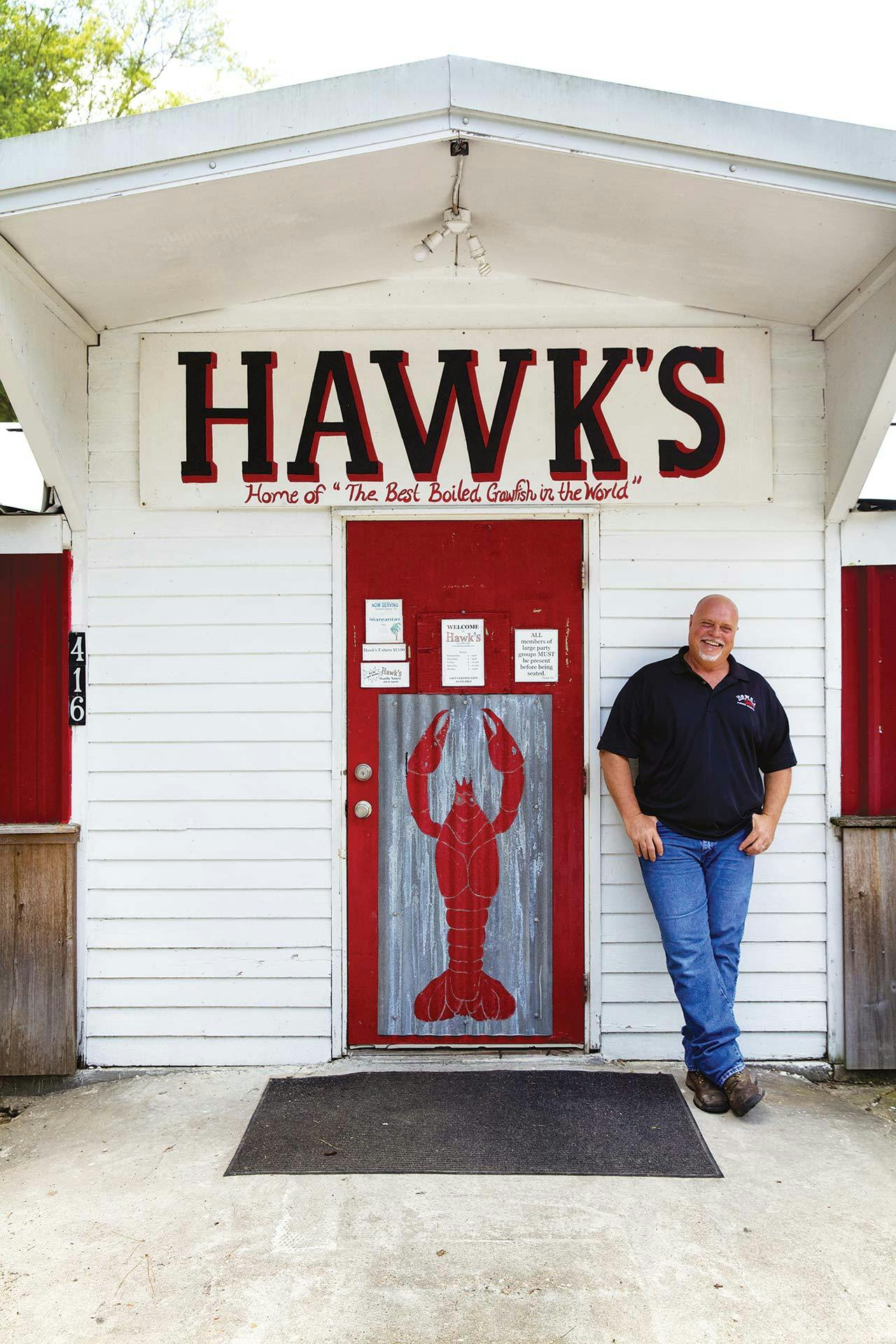
Referred to as crayfish, crawdads, mini-lobsters, or just mudbugs, these freshwater crustaceans are boiled in water flavored with Cajun spices and then served by the pound. A crawfish boil is as much a social occasion as it is a culinary one—friends, family, and strangers all gather around a steaming mound of crawfish, twisting and pulling apart the carapaces to extract the tail meat, all the while catching up and exchanging the occasional piece of gossip.
There is no better time to eat crawfish in Texas and Louisiana. Whether you prefer the garlic-and-butter-soaked Vietnamese-style crawfish that predominate in Asian communities throughout Southeast Texas or the sweeter, mellower Cajun-style flavors you find at roadside stands along the I-10 corridor from Lafayette to Houston, crawfish have never been bigger, tastier, or more widely available.
Because I grew up in Beaumont and frequently traveled to southwest Louisiana, Cajun-style crawfish was a staple of my culinary coming-of-age, along with boudin, gumbo, and étouffée. It was one of the rare strictly seasonal foods of the area; our mantra was “oysters in the winter, crawfish in the spring, blue crabs in the summer.” Every family had its favorite crawfish shack or “boiling pot,” one of the short-lived businesses that popped up in temporary buildings along the region’s backroads starting around February or March. But any discussion of the best crawfish inevitably referenced the legendary Hawk’s, north of Rayne. So it’s at Hawk’s that I’ve decided to begin my journey, a tour of the region’s best Cajun-style crawfish spots, seeking to rediscover the flavors I grew up with.
Just inside the entrance is a small vestibule, where you can almost reach up and touch the ceiling. Among the diners there’s a sense of compression and focus inherent to the process of eating crawfish; true crustacean connoisseurs will spend hours with their heads down, twisting, peeling, sucking, and tossing, while unfazed servers ferry dozens of pounds of steaming crawfish to them in round trays. Some diners wear latex gloves to ward off the wrinkly fingers that develop after hours-long sessions of peeling and eating.
I order five pounds of “hot” crawfish, which are mildly spicy. They’re also huge—as big as my hand from claw to tail—and perfectly cooked, so that the tail meat easily slips out of the shell and is tender to the bite. The flavor is pristine, without the muddy gaminess you get at many discount boiling pots. I plow through the tray of crawfish in about fifteen minutes, leaving behind a pile of shorn carapaces and dislocated heads.
I’m greeted by Anthony Arceneaux, the owner of Hawk’s, who, with his burly build, bald head, and close-cropped goatee, reminds me of a high school football coach. In a soft, precise, Cajun-accented voice, he asks me how I like the crawfish, then offers to show me his cleaning operation. We climb into his truck and trundle north on Hawk’s Road, past mobile homes and over Cole Gully to a cluster of corrugated-metal sheds. Stepping out of the truck, I hear a tinny squeal not unlike that of a dentist’s drill. The sound comes from the furiously spinning pumps that aerate the water in holding tanks where the live crawfish undergo purging, an essential and widely misunderstood step in preparing them to be eaten.
Crawfish straight out of the pond have dirt and detritus in their digestive tract, known as the hindgut. That’s the gritty black cord you often find running down the back of the crawfish after you peel it. By soaking a crawfish in fresh, aerated water for 24 to 48 hours, its hindgut is naturally purged of any material that would muddy the flavor. Almost all professional crawfish cooks say they use purged crawfish. But some take a shortcut: they soak the crawfish in a bucket of salted water for an hour or so. The salt is supposed to speed up the purging process, but the quick-soaked variety still have muddy hindguts, as well as an unpalatable saltiness.
A true purge requires large, curved-bottom water tanks, into which wire-mesh baskets filled with crawfish are lowered. Arceneaux’s operation features three of these tanks, each about the length of two cars, where live crawfish are constantly cycled in and out. Back in the eighties, he and his father, L. H. “Hawk” Arceneaux, traveled to Texas A&M University to learn the technique. Other crawfish joints don’t use it, he says, because they don’t do business on the same scale: “On a busy weekend, we push as much as two thousand pounds of crawfish through the restaurant every day. The purging process takes a lot of time and specialized equipment. It’s just not economical for a small restaurant.”
Genuinely purged crawfish like the ones served at Hawk’s are what distinguish the best of the Cajun-style crawfish pots, and they have become the holy grail of many crawfish lovers. When we return to Hawk’s, I order another five pounds and an Abita beer, while Arceneaux disappears into the back of the restaurant to help with the never-ending orders for pound after pound of boiled crawfish.

Raising crawfish is a weather game. I learn this at Cajun Claws, a popular crawfish joint in the town of Abbeville, Louisiana, where Valerie Abshire, who is employed there as a dishwasher, tells me what it’s like to work on a boat during the early-spring harvest. Her family owns three nearby ponds where they farm crawfish.
In the hot summer months, ponds are drained, and the crawfish dig two to three feet into the ground seeking coolness and moisture. Starting around October, the ponds are flooded with either well water or water pumped from small canals known as coulees. The crawfish crawl out of their burrows and begin congregating at the bottom of the pond to start eating, molting, and dispersing their hatchlings.
By November and December, if the weather hasn’t been too cold or too hot, the crawfish will grow and the population will multiply. By February and March, the crawfish are at peak size and ready for harvesting. That’s when Abshire gets busy. “Working the boat is tough,” she says. “Sometimes it’s so cold that there’s a film of ice on the water. Sometimes you’ll pull up a trap and a water moccasin will jump out at you.”
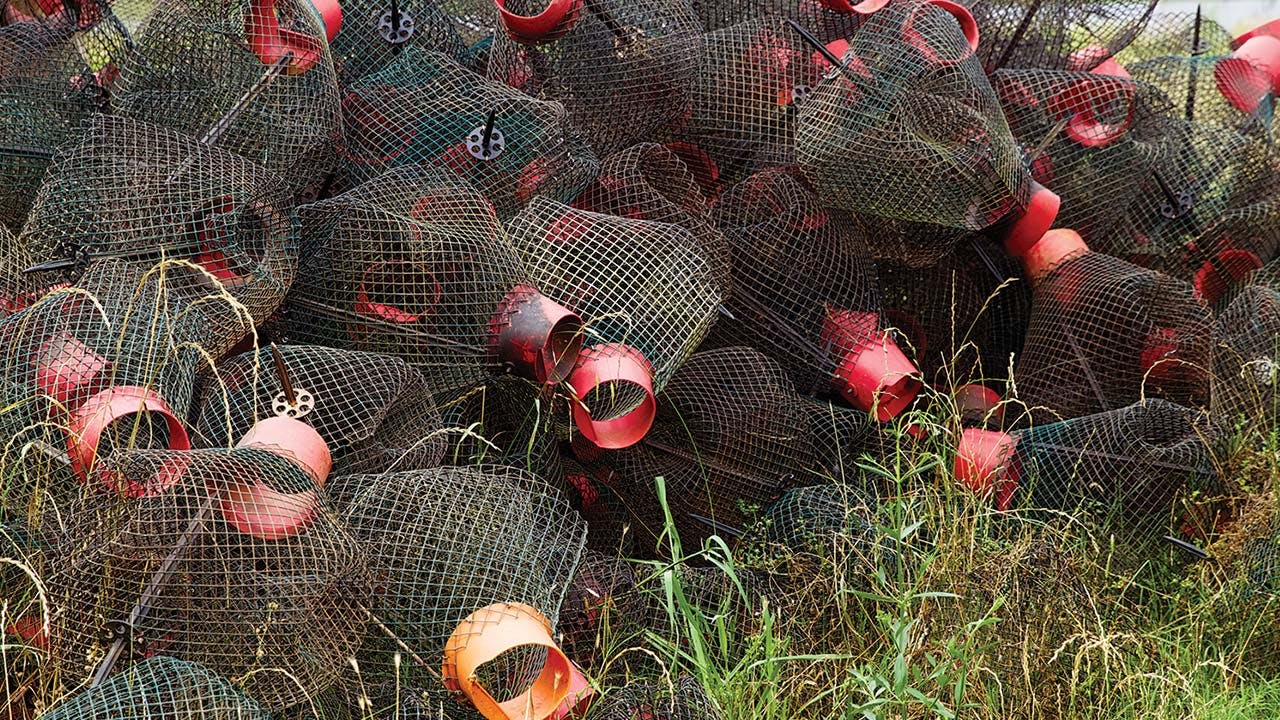
Most crawfish boats have a rudimentary device called a sorter or grader, which allows the farmer to keep the larger crawfish and send the smaller hatchlings back into the pond. Although there are no official grading standards for crawfish, they are generally sorted into three categories: peelers, field run, and select. Peelers are the smallest and are sent to processing facilities where they are hand-peeled and the tail meat is canned for use in gumbos and étouffées. Field run are small- and medium-sized crawfish that you might use for a backyard boil or find at the crawfish night at your local bar. Select crawfish are the biggest and the best, meaning they are physically intact, with no missing claws or other defects. Cajun Claws is known for boiling only the best of select-grade crawfish. It’s worth the half-hour drive south from Lafayette.
The Abbeville town square is dominated by St. Mary Magdalen Catholic Church, which attracts such a big crowd for Saturday afternoon mass that cars are double-parked around the square. After church lets out, the parishioners filter out to nearby seafood joints like Dupuy’s Oyster Shop, Black’s Oyster Bar, and Shucks Seafood House for an evening of revelry and carousing. East of the square is Cajun Claws, which draws the crawfish faithful from all over Texas and Louisiana. Though well-known to locals since it opened, media attention over the past decade has turned Cajun Claws into a tourist destination, especially on weekends.
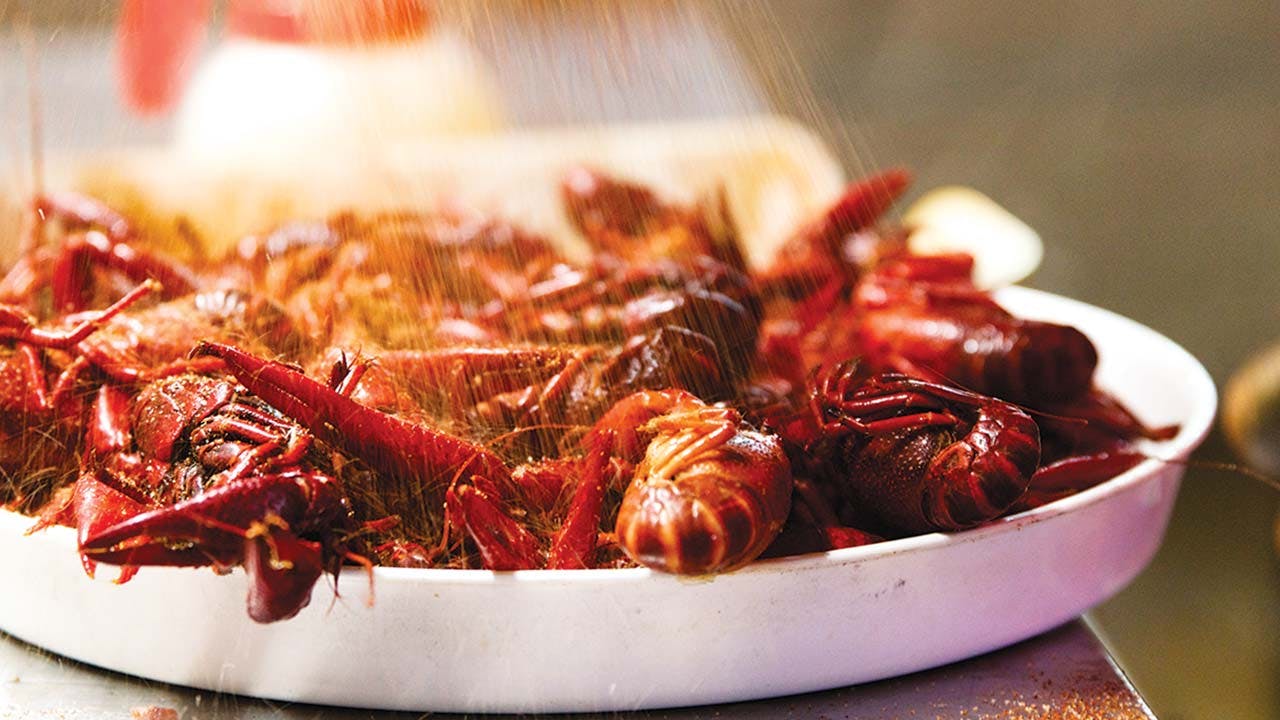
It turns out that Louisianans will happily stand in line for crawfish much as Texans will for barbecue. Here’s the system. Arrive at Cajun Claws about an hour before it opens—at four Tuesday through Thursday and at three on Friday and Saturday. Dorothy “Dot” Pere, the mother of co-owner Jodi Choate, will add your name to the List, a yellow legal pad scrawled with handwritten names. At the height of the season there are three seatings per night—at five, six-thirty, and eight. If you are one of the first fifty or sixty on the list, you’ll probably make the first seating.
I put my name on the list—number eighteen—and head for the tiny bar to wait until crawfish time. “Miss Lorie” Pere— another family member—is working the bar and takes my order. She slides an Abita Amber my way as a live crawfish scampers across the bar.
“That’s Ralphie,” says Miss Lorie. “Every night we spare a crawfish from the boiling pots. He’s like a mascot. He hangs out on the bar and entertains the guests. I’ll drop him into a ditch on the way home.”
Ralphie is perched in front of me, striking the defensive pose that all out-of-water crawfish make—tilted back on its haunches and furiously waving its claws in the air. To a novice, this may seem like a welcoming gesture that justifies the presentation of a finger as a kind of handshake. But if you’ve ever been pinched by a crawfish, you make that mistake only once.
The spicy crawfish I order at the first seating are huge and pristine and perfectly cooked. The flavors and textures are complex yet balanced, the sweetness of the tail meat combining with the gritty heat of the spice mix. Donni Choate, who opened the restaurant with Jodi, his wife, in 1996, hand-picks his crawfish, buying directly from local farmers, and cleans them at his own purging facility, similar to the one at Hawk’s. He boils them, soaks them in seasoned water, and then dusts them with a proprietary spice blend redolent of clove, cayenne, and garlic. The flavors here tend to be more complex than those at Hawk’s, where the sweetness of the crawfish meat is the star of the show. Twisting off the head yields a glorious stream of bright-yellow “fat” that’s actually the molten remains of an organ known as the hepatopancreas, which does double duty as a pancreas and liver. It has a slight taste of offal, with an ocean-y undertone. It’s a delicacy among crawfish connoisseurs.
While the southwest Louisiana cooks take a craftsman’s approach to boiling crawfish, the scene in Texas—and especially Houston—is all about volume. During the height of crawfish season, I-10 between Lafayette and Houston is like the Indy 500 for crawfish-delivery trucks. Convoys of dualies with refrigerated boxes bolted to their beds race headlong down the left lane, past lumbering eighteen-wheelers and minivans filled with families heading to Austin or San Antonio for spring break. Over the past decade, Houston’s appetite for crawfish has become all but insatiable. “I’d guess Houston consumes more crawfish than all of Louisiana,” says Jim Gossen, a longtime Houston seafood distributor.
He should know. In 1975 he moved to Houston to open an outpost of Don’s Seafood, a chain of Cajun restaurants with roots in his hometown of Lafayette. Along with business partners and high school buddies Billy and Floyd Landry, Gossen opened Don’s on South Post Oak, across from a new shopping center called the Galleria. He trucked in fresh Louisiana seafood like oysters, crabs, and a little-known Cajun delicacy, crawfish.
Gossen would bring in a few bags every week. At the time, boiled crawfish were mostly unknown in Houston restaurants. “I’d boil a pot of crawfish and use them as garnish on the étouffée to see what people would do,” says Gossen. “They wouldn’t touch ’em.” But over the years, boiled crawfish slowly caught on among Houstonians. The turning point came when Gossen partnered with Jody Larriviere and Denis Wilson to open the Magnolia Bar & Grill, on the Richmond strip, in 1983. They built an outdoor patio and a dedicated crawfish boiling kitchen and hired zydeco bands to play on the weekends. The mudbug party was on.
Then came the Vietnamese crawfish craze. Originating in Houston via the Asian shopping centers along Bellaire Boulevard and popularized in Southern California, Vietnamese-style boiled crawfish were doused in a palate-smashing soup of melted butter and chunks of fresh garlic. Cajun purists scoffed (“You can’t even taste the crawfish!”), but Houstonians ate it up, and a whole new market for crawfish sent brokers scurrying to find new sources of the in-demand crustaceans.
Southeast Texas rice farmers picked up the slack. As rice subsidies dwindled and imports surged, the landowners turned their rice fields over to crawfish farmers, or became crawfish farmers themselves. Ponds popped up along I-10 between Houston and Beaumont, and crawfish shacks soon followed. If farmers couldn’t sell their whole crop to brokers, they’d cook what was left for the locals, turning their storage sheds into boiling pots and inviting the neighbors out for weekend crawfish boils.

Seasonal crawfish restaurants started to open. In 2003 Lacy Hanks Carter was between jobs when she was asked by her dad if she’d like to go into the crawfish business. She thought he was joking, but a few months later she was standing in a one-room wood-paneled shed off FM 365 in Fannett. She put up a sign—“JuJu’s Cajun Crawfish Shak,” JuJu being the nickname given to Carter by her grandmother from Ville Platte, Louisiana—and has been boiling crawfish from February to June ever since.
Carter was born in Beaumont and lived in Lumberton before moving closer to the restaurant. During the crawfish off-season, she directs all her attention to her two elementary school–age kids, but that changes every year starting in February. “Crawfish is a ten-to-twelve-hour workday,” says Carter. “I get to see them in the morning, but they’re asleep when I get home. Sometimes my husband will bring them by the restaurant after school.”
Even though she’s surrounded by ponds, Carter still gets her crawfish from Louisiana. “They’re just better,” she says. She orders select-grade crawfish and washes them in a sink in a lean-to behind the restaurant. She’s not a fan of overnight purging. “It sucks all the flavor out of them.” Indeed, the preference among Southeast Texas crawfish aficionados tends to be the cursory hour-long purge and wash rather than the full purge used by Cajun Claws and Hawk’s. This taste for wild gaminess is a tradition in the area and extends to catfish. Most old-timers won’t touch the allegedly tasteless farm-raised catfish shipped in from Louisiana and Mississippi. Wild-caught bayou catfish, with their “muddy” taste, are preferred.
JuJu’s is a well-oiled operation. Carter’s childhood friend Jennifer Tate takes the orders; Carter’s mom assembles the three- and five-pound trays; and Carter works the boiling pots in the back. During a weekday lunch, the small dining room is full of locals. Oil-field roustabouts in denim coveralls traipse into the restaurant in socks, having left their muddy boots outside. All tables are occupied, so I ask to sit with Pauline Davis, a regular from nearby Port Acres. I order three pounds of spicy.
Davis is one of the most meticulous crawfish peelers I’ve ever met. Her typical order is “three and three”—that’s three pounds to start, followed by another three pounds of which she’ll eat as much as she can and then peel the rest to take home for étouffées and gumbos. She even picks the meat out of claws too small for most people to bother with. She snaps off the skinny side of the claw and uses that to dig the meat out of the knuckle.
“I call it a ‘Cajun toothpick,’ ” she says, waving the severed claw at me.
My tray of crawfish arrive and I dig in. The crawfish are smaller than those at the Louisiana boiling pots but still good-sized. The spice level is mild, with a fragrance of paprika and garlic. And sure enough, there’s a wild flavor to the tail meat that evokes the swampy essence of the ponds. It’s the crawfish I ate growing up, and it tastes like home.
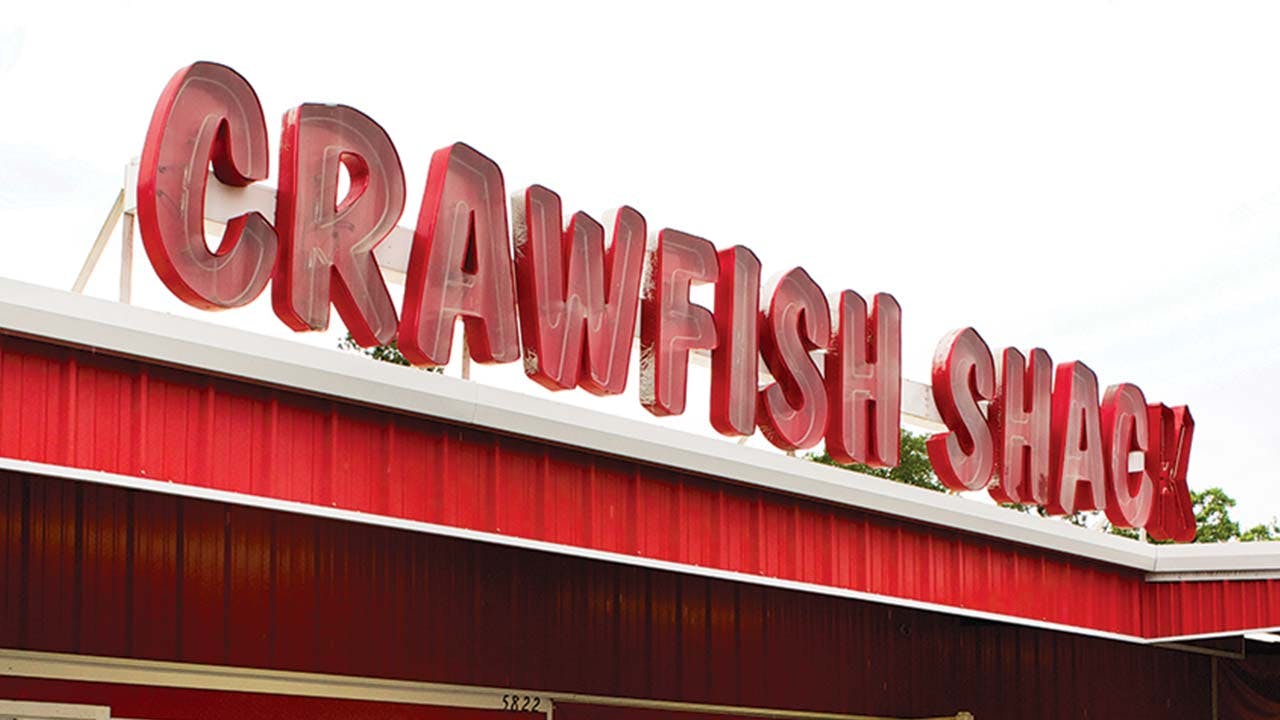
Whenever someone asks me where to eat Cajun-style crawfish in Houston, I tell them to drive to the small town of Crosby, 25 miles northeast of downtown, where Dan Meaux is the impresario of one of the most raucous Southeast Texas boiling pots, Crawfish Shack. Early in the season, a few hundred of the faithful line up in the morning for a noon opening. They bring folding chairs and coolers of Budweiser and Miller Lite. With a mix of locals and Houstonians and a surprising number of loyal customers from distant suburbs like Katy and Sugar Land, there’s a lively party atmosphere worthy of any bar or boiling pot in Louisiana.
If there’s a poster boy for the wild success of crawfish in Houston, it’s Meaux. Tall, athletic, and immaculately groomed, he’d look a lot like a high-priced Houston attorney if you suited him up in a two-piece pinstripe. But for now he darts around Crawfish Shack in a T-shirt, shorts, and running shoes, making sure his high-volume, high-energy crawfish operation is running smoothly.
Meaux has crawfish bona fides. He grew up in Rayne and frequented Hawk’s. He studied hotel and restaurant management at the University of Houston and while in school worked as a manager for Pappas Restaurants. In 2004, riding the Houston crawfish wave, he and his wife, Jennifer, opened a drive-through-only crawfish shack in Crosby. Five years later he moved down the road to his current location, added a metal shed, and set up eleven tables for dine-in orders. Today the operation has grown to dozens of picnic tables arrayed under a rambling agglomeration of crawfish-red, steel-framed dining sheds. Vegas-like neon letters march across the roof, spelling out “CRAWFISH SHACK.”
Meaux claims to cook the most crawfish of any Texas boiling pot. On weekends during the height of the season he’ll boil 6,000 pounds per day. His all-time record is 7,100 pounds.
What accounts for the popularity of Crawfish Shack? The crawfish, to start. Meaux sources select-grade crawfish from Louisiana and employs a thorough wash and a quick purge of forty minutes in aerated water. His crawfish strikes a balance between the pristine sweetness of Cajun Claws and the wilder taste of JuJu’s. Meaux also credits his spice mix. “We use a lot less salt than other places,” he says. “It allows the flavor of the other spices and the crawfish to come through.”
Another reason for his success is the state of Cajun crawfish in Houston proper. Seasonal boiling pots pop up inside the Beltway, usually in down-at-the-heels suburban strip malls, while closer in, neighborhood bars hire freelance boilers to cook for patrons. The quality is not always good. The crawfish are field-run grade, treated to a cursory wash, with little or no purging. There’s often no hand-culling, so crawfish that are dead before they’re boiled—recognizable by their straight tails—will sneak onto a tray. What’s more, the Vietnamese-style outlets scoop up much of the select-grade crawfish heading into Houston from points east.
Back at Crawfish Shack, I order three pounds of spicy (you can also get the “Meaux (Mo) Spicy” if you want more heat). I’ve arrived toward the end of the season, in late May, and the crawfish are big but have harder shells, which take more work to break through. The meat’s tougher and less sweet. I’ve been eating crawfish every weekend for the past couple of months and, far from being tired of it, I find that this batch satisfies just as much as the first I had, in February.
I’ll sneak back in a couple of weeks after Meaux has closed his dining room and only the drive-through is open. I’ll get three pounds in a paper sack, park in the lot, and eat them while standing at the trunk of my car. By then crawfish season will be over. Time for some blue crabs.
GET YOUR CRAWFISH HERE
Hawk’s Restaurant
Spicy crawfish is the main course, but leave room for dessert, especially the decadent bread pudding. 416 Hawk’s Rd., Rayne, LA., 337-788-3266.
Cajun Claws
While waiting for a table, head over to the bar, where Ralphie, the restaurant’s crawfish mascot, skitters back and forth. 1928 Charity, Abbeville, LA. 337-893-9437
JuJu’s Cajun Crawfish Shak
Ask for the three house-made dipping sauces—a red cocktail sauce, a pink mayo-spiked concoction, and a glorious cup of clarified butter. BYOB. 18277 FM 365, Fannett, TX., 409-794-2020
Crawfish Shack
No time to stand in line? Hit the fast-moving drive-through window and grab a paper sack of steaming crawfish to take home. BYOB. 5822 FM 2100, Crosby, TX. 281-462-2121.
Crawfish Shack #2
38925 FM 1774, Magnolia, TX. 281-789-4555
Crawfish season generally runs from February to June. Opening days and hours for crawfish restaurants are usually determined by availability. It is always recommended to call ahead.
For many crawfish restaurants, their Facebook page is the preferred channel for announcing availability and days and hours of opening.
- More About:
- Longreads

